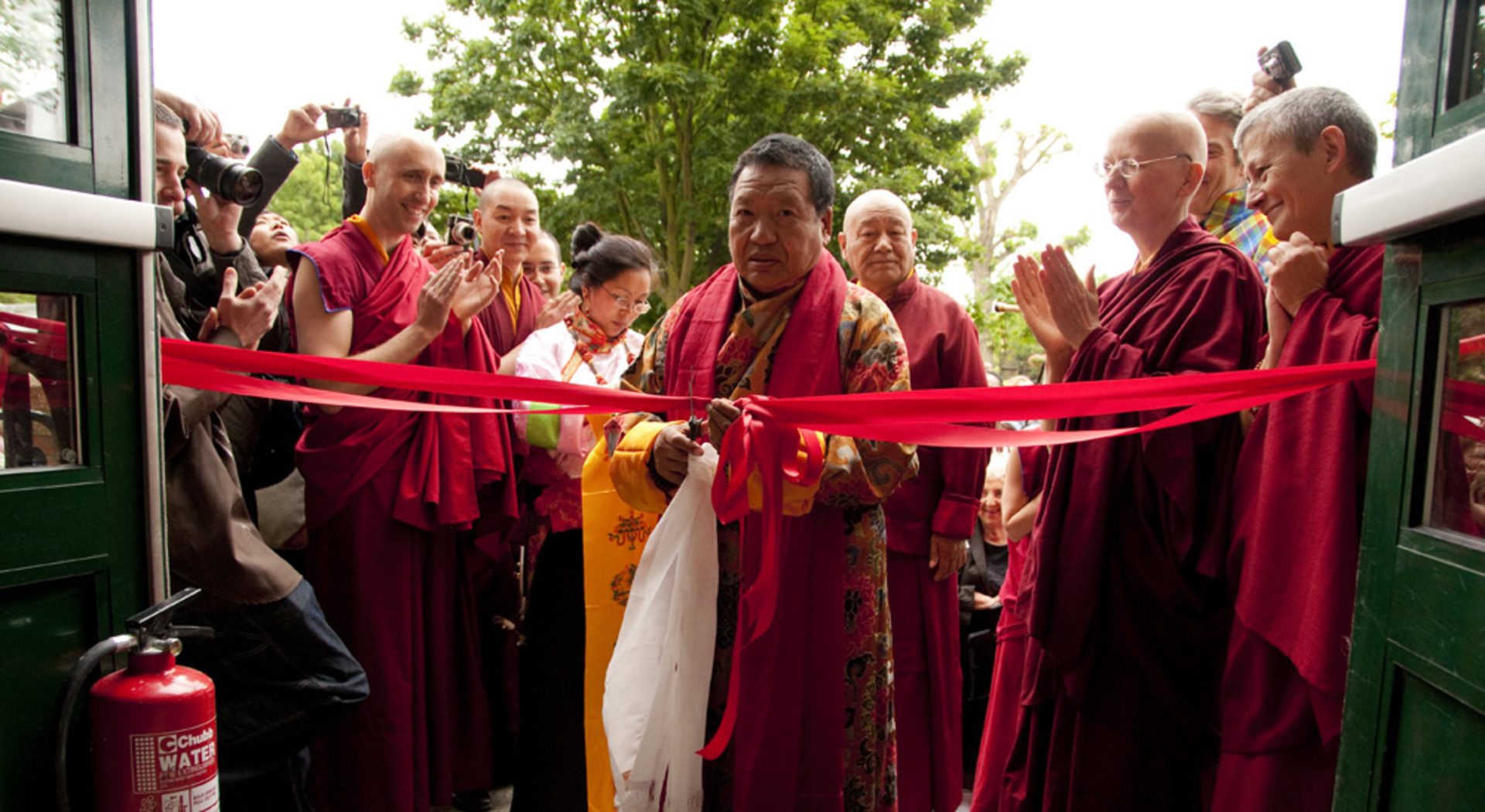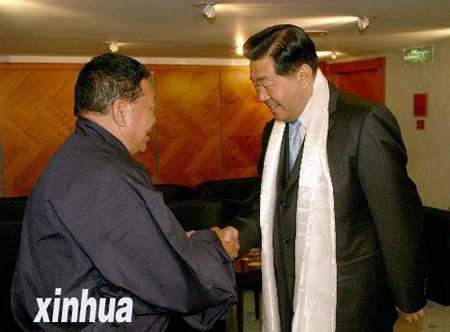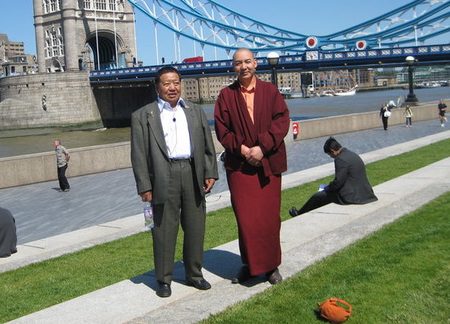
Born: 1939, Kham, Tibet | Died: 2013, Chengdu, China (murdered)
Full name: Shetrup Akong Tarap
Name in Chinese: 活佛阿貢 (huófó āgòng; “Living Buddha Akong”)
Akong Tulku (1949-2013) was a Tibetan religious figure. He co-founded the first Tibetan Buddhist monastery in Great Britain and directed a charitable organisation which has been active in Tibet. From the early 1980s up until his murder in October 2013, Akong had played an important role in China’s soft power concerning Tibet. He earned the distinction “senior United Front figure” due to his cooperation with the CCP’s United Front Work Department (UFWD). His relationship with the UFWD, as well as his financial and practical contributions to China’s soft power, accorded him the protection – for some time – of those within the highest echelons of the Chinese state.
In 1959 Akong fled into exile in India with the Buddhist lama Chogyam Trungpa. The pair then immigrated to Great Britain, where Akong became a naturalised British citizen. They established Samye Ling, a centre of Tibetan culture in Scotland. Akong usurped Trungpa’s authority and took over the centre’s leadership. Samye Ling’s fame grew and in 1980 Akong established a charitable organisation called “Rokpa” together with a former Swiss actress, Lea Wyler.
By 1983, Akong had raised enough to make his first trip back to Tibet. During Hu Yaobang’s period of reform, a patriotic Buddhist revival was underway in China. As Akong explained in a 2007 interview for the French branch of Rokpa, it was on his way back to Britain after this first visit when he was recruited by the UFWD in Beijing. Akong returned to Tibet in 1984 and was given responsibility for financing the Tibet Development Fund (TDF), a UFWD-directed GONGO (Government-Organised Non-Governmental Organisation) whose fundraising range included overseas “patriotic Tibetans” (i.e. those supportive of the CCP). The TDF website lists “British Patriotic Tibetan Akong” as having given first in 1989 an amount of 152,500 Yuan to support Chinese “Education” in Chamdo Prefecture. The TDF intended to fill Chinese rather than Tibetan coffers in the region. Akong proved effective at this diversification of the “Tibetan cause”, raising substantial sums of money from European donors during the following decades. While corruption is still the norm in China even with the nation’s rising economic power, it is inconceivable that during the era of intense poverty in which Akong worked, that bribery could be avoided.
As Akong continued to cooperate with the UFWD and Rokpa’s fundraising progressed, so did his rank in the unofficial guanxi hierarchy of Chinese leadership. Complying with its rules of mutual reciprocity, he returned to Tibet each year, and by 2006 had reached the highest level. This was demonstrated by his reception in London by Jia Qinglin (No.4 in the Politburo during the leadership of Hu Jintao). Furthermore, in July 2011 Akong was a guest of honour at conference for “patriotic Tibetan representatives” in Lhasa. It was a part of the 60th anniversary celebrations of the so-called “peaceful liberation” of Tibet by the People’s Liberation Army.
Central to Akong’s progress was his assignment in 1992 to engineer the discovery and official appointment by China (via the State Bureau for Religious Affairs, the Buddhist Association of China and the UFWD), of the Tibetan heirarch Karmapa Ogyen Trinley Dorje. Akong was also appointed as an Executive Director of the highly nationalistic China Association for the Protection and Development of Tibetan Culture (CAPDTC), a GONGO concerned with soft power outreach on Tibet (an offshoot of the UFWD), which plays a key role in the “normalisation” of Tibet.
After his recruitment by the UFWD, Akong’s cooperation never ceased. In particular, the 1990s and 2000s marked a bountiful period for his fundraising via Rokpa. He was able to return to Tibet each year, and through his control of dozens of projects, deepen his guanxi with the CCP leadership.

Akong Tulku greets Politburo No.4 Jia Qinglin in London,
October 2006 (Photo: Xinhua)
On 23 October 2006 Jia Qinglin, then No.4 in the CCP Politburo Standing Committee, made his first official visit to Britain. He showed himself via Chinese state media bowing slightly – but sufficiently – before Akong at the Royal Garden Hotel in Kensington, London, where Jia was hosted. It was the day before Jia’s first meeting with British PM Tony Blair. Jia expressed his firm support for Akong as well as his expectation for this to be reciprocated by Akong’s further contributions to “a prosperous and stable Tibet”.
The next day, Tibetan and British activists from the UK’s Tibet Society gathered outside Jia Qinglin’s window at the Royal Garden Hotel. They exclaimed “China out of Tibet,” “Blair Get Tough on China,” and slogans related to the Nangpa-La incident, in which Tibetan escapees at the Nepal border were gunned down by Chinese forces the previous month. During the protest, two coach loads of Chinese supporters arrived and tried to storm the Tibetan protesters, who had earlier been cordoned-off into a crowd control enclosure by police.
By way of contrast, when the Dalai Lama’s Special Envoy Lodi Gyari, a key person in negotiations with the Chinese and American governments, visited Beijing in November 2008, he was officially received by Du Qinglin, then Vice Chairman of the Chinese People’s Political Consultative Conference (CPPCC) and Director of the UFWD. Du Qinglin was the No.2 to Jia Qinglin, then CPPCC Chairman, for whom an official reception for a man of Lodi Gyari’s status would have been seen as too much of an honour. Akong however was received by the No.1, showing the official character of his mission towards China, the respect he was afforded by the Chinese both at home and overseas, and the level of his rank at the time in the unofficial hierarchy of the Chinese establishment guanxi. To the Chinese people at the time, it demonstrated how much Akong was protected.
The significance of the meeting between Jia and Akong in London is the prominent role that such “Patriotic Tibetans” play in the game of Chinese soft power, and the duty accepted by these individuals to exert influence over foreign opinion of the CCP’s Tibet policy.
In July 2010 Akong and Jia Qinglin were shown together at the Members Congress of the CAPDTC. The CAPDTC was founded in 2004 by Ngapoi Ngawang Jigme and the UFWD to “vigorously develop the new socialist culture of Tibet”. Its leadership comprises CCP officials from entities such as the UFWD and the State Administration for Religious Affairs (SARA). As such, “cultural development and protection” should be understood correctly to denote the development of Tibetan culture towards conformity with the Chinese system and Han cultural dominance, and protection from “separatist forces”. In the official photograph of the 2010 delegate line-up, Akong is pictured with other CAPDTC delegates, positioned in the middle of the second rank, directly behind Jia Qinglin and Du Qinglin.
In a speech which drew international criticism, Jia Qinglin described the CAPDTC as “an important platform for foreign propaganda about Tibet and Tibetan culture”. He affirmed the CCP’s strong support, expecting the association to “always hold high the banner of patriotism and national unity” and “thoroughly expose and criticise the reactionary nature of the Dalai clique to split the motherland”. After the event Akong received an award from the CAPDTC for the millions of dollars in funds raised by Rokpa in support of its work. Later that year in October, Akong returned to China an overseas guest of honour to celebrate the founding of the Ganzi Prefecture (traditionally part of the historical region of Kham).
In July 2011 Akong was a guest of honour at conference for “patriotic Tibetan representatives” in Lhasa. It was a part of the celebrations of the so-called “peaceful liberation” of Tibet by the People’s Liberation Army in 1951. After posing for photos with UFWD officials, the delegates sat down at a banquet to listen to a speech by Zhu Weiqun, the key interlocutor in the talks between the PRC and the Dalai Lama’s envoys (which finally collapsed in 2012). Zhu expressed his appreciation for the representatives’ “positive contribution in their respective fields for the development and stability in Tibet.”
In a Chinese television broadcast of the event, uploaded to YouTube under the heading “Exiled Tibetan Traitors”, the delegates are shown seated at the banquet listening to Zhu Weiqun’s speech, as well as that of his colleague Qi Zhala, then Vice Chairman of the TAR’s UFWD Standing Committee. Akong is seen with Gangchen Tulku, his counterpart for Tibetan Affairs in Italy. Akong can be seen at 1:31 (wearing a grey chuba) at the far left of the shot (furtively turning his head to avoid the camera). His place at the head table is just in the middle, directly opposite Zhu Weiqun, showing that he is one of the most important guests.
Later that month, Akong together with Gangchen attended the Third Tibetan Cultural Forum in Lhasa, which was organised by the CAPTDC, the China Tibetology Research Centre and Tibet University. The next year, Akong was a delegate at the third World Buddhist Forum in Hong Kong.
Numerous explanations have been presented for Akong’s warm relations with the Chinese authorities by apologists. For example, it has been posited that Akong’s ease of entry into Tibet was because he was not involved with “Tibetan exile politics”, in reference to the fact that overseas Tibetans involved with Tibetan independence organisations are blacklisted by Beijing and forbidden entry to Tibet. Others have argued that he was “obliged” to maintain such relationships in order to make his humanitarian work effective. Nonetheless, few overseas Tibetans have gone to the lengths Akong did to accommodate the Chinese authorities, particularly in their own adopted homelands. The promotion by Chinese state media of Akong’s overseas outreach (e.g. the opening of the London branch of his organisation in 2007) was unmatched by any other Tibetan undertaking charitable works in China. Likewise, few overseas Tibetans have maintained such regular and close relations with their local Chinese embassies.
Akong’s connections with the Edinburgh Chinese Embassy and its General Consul staff in Scotland are a matter of record. In August 2008, Consul General Tan Xiutan attended the celebrations of the 41st anniversary of the founding of the Samye Ling Tibetan Centre. She congratulated the two “Living Buddhas” (Akong and his brother Yeshe Losal) for their contributions to the construction of the motherland. A few months after the brutal suppression of Tibetan protesters in Lhasa in the run-up to the Beijing Olympics, the two men warmly congratulated the Consul General over the Olympic opening ceremony, adding that they believed it would become the “most successful Olympics in history”. Akong reiterated his commitment to continue making contributions to the motherland.
In August 2009 Consul General Tan Xiutian, having just returned from an inspection tour of Tibet, was welcomed back for an inspection tour of Samye Ling Tibetan Centre, and embraced by Yeshe Losal. Tan Xiutan said she had “witnessed the significant social, economic and cultural achievement of Tibet after 50 years of democratic reform”, adding that “People of all ethnic groups live and work in harmony. They love each other and help one another” and that Tibetan culture (as a component of Chinese culture) was “thriving”. She articulated her expectation that the two brothers would “continue to care about and make more contributions to the development of the Tibetan Autonomous Region”.
Three months later, in November 2009, Tan Xiutan was back at Samye Ling, this time accompanying a delegation from mainland China travelling under the banner of the “China Tibet International Culture Association” and headed by Shen Kai-yun, Deputy Minister of the TAR CCP Propaganda Department. Shen, a colleague of Akong in the CAPDTC serving as its Executive Director, was visiting Europe to “introduce the British and French people to the real Tibet”. Shen’s delegation were received by Akong’s assistant Veronika Player. After making an inspection tour of Samye Ling, they took the time to brief Player and Akong’s staff team on Tibet’s “development and progress” under Chinese rule.
In August 2010 Deputy Consul General Zhou Youbin represented the Consulate on its annual inspection visit to Samye Ling. He conveyed the greetings of Tan Xiutan and praised Akong for helping the people of Scotland to have the opportunity to better understand the “diversity of Chinese culture”, and thanked him for continuing “to show concern and support for the construction of the motherland” and his contribution to the “harmony” of ethnic groups. In September 2010, representatives of Samye Ling gathered together with Tan Xiutan and other dignitaries at the Chinese consulate to celebrate the PRC’s 61st National Day. Akong and Veronika Player were back at the consulate in February 2011 as Tan Xiutan’s guests for celebrations of the Chinese New Year. They listened to Tan’s speech about the friendly and cooperative relations between China and Scotland, and promises of giant pandas for Edinburgh’s Zoo.
In August 2011, Deputy Consul General Zhou Youbin returned to Samye Ling, this time praising Akong for promoting China’s narrative of “Tibetan culture”, and conveying the greetings of the newly appointed Secretary General, Li Ruiyou. In August 2012 Samye Ling received Li Ruiyou in person. Li thanked Akong and his brother for their cooperation with China in the “promotion of Tibetan culture and cultural exchanges”, as well as giving formal thanks for their supportive contributions made over the years.

Akong Tulku together with his murderer-to-be,
Thubten Kunsal in London, 2010
And yet, the status and protection Akong enjoyed at the very highest level did not endure long enough to prevent his mysterious murder in western China on 8 October 2013. Akong and two companions (his nephew and driver) were stabbed to death by a trio of fellow Tibetans over an alleged “economic dispute”. The perpetrators, led by a Tibetan artisan Thubten Kunsal who had worked for Akong in the UK and is said to have been previously married to Akong’s niece, were arrested and reported to have “immediately confessed”. It is not known why the assailants carried knives to negotiate over money and after a “verbal disagreement” they murdered not only Akong but also his companions, leaving nobody alive. Two of the assailants were later sentenced to death.
Among the obituaries and messages of condolence was the hope conveyed by Karmapa Ogyen Trinley Dorje that all of Akong’s visions and aspirations would continue to be fulfilled.